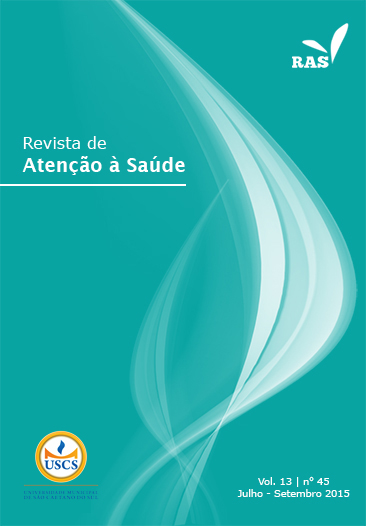MUSCULOSKELETAL COMPLAINTS IN MOTORCYCLE TAXI PILOTS
DOI:
https://doi.org/10.13037/ras.vol13n45.2789Keywords:
Musculoskeletal system, workers, occupational health.Abstract
quickness and access to remote areas. But few studies analyze the postures adopted in this profession that,when inadequate, can cause disorders that unable one from developing his activities. Objectives: To raisethe musculoskeletal symptoms and their pain degree; to study the relationship between musculoskeletalsymptoms and factors related to work and conduct a biomechanics analysis in postures adopted in themotorcycle taxi pilot activity. Material and methods: The study was conducted with 20 motorcycle taxipilots from a small city in Paraíba, whom were chosen randomly. A semi-structured questionnaire wasused in the research, as well as the Corlett’s corporal diagram and the REBA ergonomic software analysis.The relationship between the musculoskeletal symptoms and the variables: age, service time and workhours was analyzed by the student t test. Results: This profession involves young individuals with lowacademic levels, that submit themselves to long working hours. Pain was referred by 10 pilots with greaterincidence among the individuals, with 20 to 30 years of age. The body part most compromised was the back. Working hours were significantly higher among the pilots that referred pain (p=0.01). Conclusion:Musculoskeletal symptoms are compatible with sitting work postures, and the biomechanical risk whileconducting the vehicle is medium, demanding changes. Working hours can be a risk factor for the developmentof the disorders in these workers.Downloads
References
1. Silva EP, Souza AP de, Minette LJ, Baeta F da C, Vieira HANF. Avaliação biomecânica do trabalho de extração manual de madeira em áreas acidentadas. Sci For. 2008;36(79):231-5.
2. Másculo FS. Biomecânica. In: Másculo FS, Vidal MC, editores. Ergonomia: trabalho adequado e eficiente. Rio de Janeiro: Elsevier/ABEPRO; 2011.
3. Punnett L, Wegman DH. Work-related musculoskeletal disorders: the epidemiologic evidence and the debate. J Electromyogr Kinesiol Off J Int Soc Electrophysiol Kinesiol [Internet]. fev. 2004;14(1):13-23. Disponível em: <http://www.ncbi.nlm.nih.gov/pubmed/14759746>. [acesso em 14 jul. 2014].
4. Aptel M, Aublet-Cuvelier A, Claude Cnockaert J. Workrelated musculoskeletal disorders of the upper limb. Jt Bone Spine [Internet]. Dez. 2002;69(6):546-55. Disponível em: <http://linkinghub.elsevier.com/retrieve/pii/S1297319X02004505>. [acesso em 14 jul. 2015].
5. Söderback I, editor. International handbook of occupational therapy interventions. London: Springer; 2009.
6. Barbosa LG. Fisioterapia preventiva nos Distúrbios Osteomusculares Relacionados ao Trabalho – DORTS: a fisioterapia do trabalho aplicada. 2a ed. Rio de Janeiro: Guanabara Koogan; 2009.
7. Fonseca NRR da. Sobre duas rodas: o mototáxi como uma invenção de mercado. Democr Viva. 2006;31:3-9.
8. Fonseca NRR da. Sobre duas rodas: o mototáxi como uma invenção de mercado [Dissertação]. Programa de Mestrado em Estudos Populacionais e Pesquisas Sociais da Escola Nacional de Ciências Estatísticas. Rio de Janeiro; 2005.
9. Gomes AN, Duque ANF. Mototáxi: uma alternativa no transporte urbano de Sobral? Rev Homem, Espaço e Tempo. 2009;124-40.
10. Gyi DE, Porter JM. Musculoskeletal problems and driving in police officers. Occup Med (Chic Ill) [Internet]. 1998;48(3):153-60. Disponível em: <http://occmed.oxfordjournals.org/cgi/doi/10.1093/occmed/48.3.153>. [acesso em 14 jul. 2015].
11. Umi KMS, Karmegam K, Shamsul BMT, Irniza R, Ayuni NA. Interventions to reduce musculoskeletal disorders among motor vehicle workers: a review. Adv Environ Biol. 2014;8(15):219-24.
12. Karmegam K, Ismail MY, Sapuan SM, Ismail N, Bahri MTS, Shuib S, et al. A study on motorcyclist’s riding discomfort in Malaysia. Eng e-Transaction. 2009;4(1):39-46.
13. Deliberato PCP. Fisioterapia preventiva: fundamentos e aplicação. Rio de Janeiro: Manole; 2002.
14. Iida I. Ergonomia: projeto e produção. 2a ed. São Paulo: Edgard Blucher; 2005.
15. Corlett E, Bishop R. A technique for assessing postural discomfort. Ergonomics. 1976 Aug;19:175-82.
16. Hignett S, McAtamney L. Rapid Entire Body Assessment (REBA). Appl Ergon [Internet]. 2000 Apr;31(2):201–5. Disponível em: <http://linkinghub.elsevier.com/retrieve/pii/S0003687099000393>. [acesso em 14 jul. 2015].
17. Brasil. Constituição da República Federativa do Brasil. Brasília (DF): Senado Federal; 1988.
18. Colman J. Acidente de trabalho: a caracterização objetiva das Lesões por Esforço Repetitivo (LER) [Dissertação]. Ponta Grossa: Universidade Estadual de Ponta Grossa; 2006.
19. Carvalho MMMJ. Dor: um estudo multidisciplinar. São Paulo: Summus; 1999.
20. Figueiredo FGC. Experiência e regulação da carga de trabalho: o caso do maquinista de conicaleira experiente em uma indústria têxtil [Dissertação]. Belo Horizonte: Universidade Federal de Minas Gerais; 2009.
21. Barreto RP. Moto táxi: subemprego e degradação do homem. III Seminário Política Sociais e Cidadania; 24-26 novembro 2010; Salvador. Salvador: Universidade Católica do Salvador; 2010.
22. Cavini A, Souza MJS. O impacto do setor de mototáxi na cidade de Poços de Caldas - MG. Gestão e Conhecimento. 2006;3(1).
23. Garcia VMD, F MC, Corrêa DF, Pimenta RU. Análise do perfil do paciente portador de doença osteomuscular relacionada ao trabalho (DORT) e usuário do serviço de saúde do trabalhador do SUS em Belo Horizonte. Rev Bras Fisioter. 2004;8(3):273-8.
24. Rodrigues AC. Aspectos da ergonomia que contribuem na prevenção das LER/DORT num setor da indústria cerâmica: um estudo de caso [Dissertação]. Florianópolis: Universidade Federal de Santa Catarina; 2003.
25. Salim CA. Doenças do trabalho: exclusão, segregação e relações de gênero. São Paulo em Perspect. 2003;17(1):11-24.
26. Karmegam K, Sapuan SM, Ismail MY, Ismail N, Shamsul Bahri MT, Seetha P. Motorcyclist’s riding discomfort in Malaysia: comparison of BMI, riding experience, riding duration and riding posture. Hum Factors Ergon Manuf Serv Ind [Internet]. 2013 Jul 27;23(4):267-
78. Disponível em: <http://doi.wiley.com/10.1002/hfm.20317>. [acesso em 14 jul. 2015].
27. Balasubramanian V, Jagannath M. Detecting motorcycle rider local physical fatigue and discomfort using surface electromyography and seat interface pressure. Transp Res Part F Traffic Psychol Behav [Internet]. Jan. 2014;22:150-
8. Disponível em: <http://linkinghub.elsevier.com/retrieve/pii/S1369847813001393>. [acesso em 12 jan. 2015].
28. Merlo ÁRC, Jacques M da GC, Hoefel M da GL. Trabalho de grupo com portadores de LER/DORT: relato de experiência. Psicol Reflexão e Crítica. 2001;14(1):253-8.
29. Burin T, Barbieri DF, Galiano P, Santos R V. Presença de LER/DORTs em um grupo de bancários da cidade de
Ercehim - RS. Perspectiva. 2011;35(129):93-102.
30. Peres CC. Ações coletivas para prevenção de LER/DORT. Bol Saúde. 2005;9(1):39-50.
31. Karmegam K, Ismail MY, Sapuan SM, Ismail N. Conceptual design and prototype of an ergonomic back-leaning posture support for motorbike riders. J Sci Ind Res. 2008 Aug;67:599-604.
32. Wely P Van. Design and disease. Appl Ergon. 1970 Dec;1:262-9.
33. Grandjean E, Honting W. Ergonomics of posture: review of various problems of standing and sitting posture. Appl Ergon. 1977;8(3):135-40.
34. Santos FAS, Silva Filho AC, Medeiros ICP, Silva JIO. Análise da prevalência de algias na coluna em mototaxistas. Gestão, Educação e Promoção da Saúde. CONVIBRA; 2013. Disponível em: <http://www.convibra.com.br/upload/paper/2013/80/2013_80_7818.pdf>. [acesso em 14 jul. 2015].
35. Walsh IAP, Corral S, Franco RN, Canetti EEF, Alem MER, Coury HJCG. Capacidade para o trabalho em indivíduos com lesões músculoesqueléticas crônicas. Rev Saúde Pública. 2004;38(2):149-56.
36. Vergara M, Page Á. Relationship between comfort and back posture and mobility in. Appl Ergon. 2002;33:1-8.
Downloads
Published
Issue
Section
License
Copyright (c) 2015 Deyse Xavier de Sousa França, Hanne Alves Bakke

This work is licensed under a Creative Commons Attribution-NonCommercial-NoDerivatives 4.0 International License.
Policy Proposal for Journals offering Free Delayed Access
Authors who publish in this magazine agree to the following terms:
- Authors maintain the copyright and grant the journal the right to the first publication, with the work simultaneously licensed under a Creative Commons Attribution License after publication, allowing the sharing of the work with recognition of the authorship of the work and initial publication in this journal.
- Authors are authorized to assume additional contracts separately, for non-exclusive distribution of the version of the work published in this magazine (eg, publishing in institutional repository or as a book chapter), with the acknowledgment of the authorship and initial publication in this journal.
- Authors are allowed and encouraged to publish and distribute their work online (eg in institutional repositories or on their personal page) at any point before or during the editorial process, as this can generate productive changes, as well as increase impact and citation of the published work (See The Effect of Open Access).









